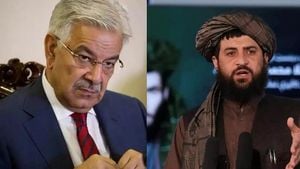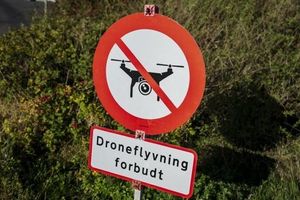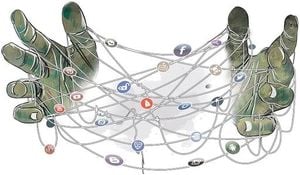Just days before the anniversary of September 11, 2025, the United States finds itself at the heart of a storm over its foreign and domestic policies—policies that, according to critics and observers, are isolating the country abroad and dividing it at home. In the span of a few weeks, President Donald Trump’s administration has overseen dramatic escalations on both fronts: a foreign policy that has driven traditional rivals into tighter alliances and a Supreme Court ruling that has ignited fears of legalized racial profiling within U.S. borders.
On the world stage, the past month has seen a flurry of high-stakes diplomacy—just not the kind the U.S. might have hoped for. As reported by Between The Lines, former President Trump met with Russian President Vladimir Putin in Alaska to discuss the ongoing war in Ukraine. Not long after, Putin was in Beijing, joining North Korean leader Kim Jong Un and Chinese President Xi Jinping at a military parade marking 80 years since the end of World War II. Days earlier, Indian Prime Minister Narendra Modi had sat down with both Putin and Xi at the Shanghai Cooperation Organization summit, signaling a shift in allegiances that has raised eyebrows in Washington.
According to Melvin Goodman, a senior fellow at the Center for International Policy and a former CIA analyst, these moves are no coincidence. “We’re taking steps that have driven China and Russia into the closest relationship they’ve ever had in history—in their very long history,” Goodman told Between The Lines. “And I’m not just talking about the joint military exercises and the generous exchanges of military intelligence and military weapons, but the fact that Putin and Xi Jinping have become very close and we’ve played a role in that and driving them into each other’s arms.”
Goodman points out that India, once a key U.S. partner, has been drifting away, especially after Trump’s recent decision to double tariffs on Indian goods to 50 percent as punishment for India’s continued purchase of Russian oil. “Our relationship with Modi has really gone down the tubes. India is a very important country now. Modi obviously is rushing to get on good terms with Xi Jinping,” Goodman observed. This, he argues, is a self-inflicted wound, one that could have long-term consequences for U.S. influence in the region.
But the realignment doesn’t stop at India. North Korea, historically wary of China, is now strengthening its ties not just with Beijing but also with Moscow. “North Korea… now has a very close relationship with Russia, very supportive of the Ukraine war, sending personnel, sending weaponry, and now improving relations with both Beijing and Moscow and giving North Korea access to more sophisticated military technology,” said Goodman. He attributes much of this to what he calls Trump’s inattentiveness: “Trump is paying no attention whatever to these issues. We don’t really have a functioning secretary of state or a functioning national security advisor.”
Meanwhile, the last remaining strategic arms agreement between the U.S. and Russia is set to expire in February 2026, raising the specter of a new arms race. Goodman is blunt about the risks: “Everywhere I look, I see the potential for further disaster. And a lot of it is self-inflicted wounds. We’re doing this to ourselves. Trump is doing this to the United States.”
While America’s alliances fray abroad, domestic tensions are boiling over at home, especially in California. On September 10, 2025, the U.S. Supreme Court issued an emergency ruling allowing roving immigration raids in Los Angeles—raids that, for the first time, permit stops based on race or apparent ethnicity. Justice Brett M. Kavanaugh, writing a concurring opinion, argued that “common sense” should guide what constitutes reasonable suspicion for immigration stops, a standard that critics say effectively legalizes racial profiling.
As reported by the Los Angeles Times, the ruling’s impact stretches far beyond Latino communities. While Latinos remain the largest group affected—nearly 18,000 Mexicans and almost 14,000 Guatemalans and Hondurans have been detained by ICE since October 2024—more than 2,800 Indians, over 1,400 Chinese, and thousands from African countries have also been caught in the dragnet. “Brown people, speaking brown languages, hanging out with other brown people, and doing brown people things like working low-wage jobs now meets the legal standard of ‘reasonable suspicion’ required for immigration stops,” the Los Angeles Times editorialized, capturing the anxiety running through California’s immigrant communities.
Governor Gavin Newsom didn’t mince words in his response, stating on social media, “This isn’t about enforcing immigration laws—it’s about targeting Latinos and anyone who doesn’t look or sound like Stephen Miller’s idea of an American, including U.S. citizens and children, to deliberately harm California’s families and small businesses.” He warned that “Trump’s private police force now has a green light to come after your family—and every person is now a target.”
Justice Sonia Sotomayor, in a stinging dissent, wrote that the ruling violates Fourth Amendment protections against arbitrary law enforcement interference. “After today,” she wrote, “that may no longer be true for those who happen to look a certain way, speak a certain way, and appear to work a certain type of legitimate job that pays very little.” She called the decision “unconscionably irreconcilable” with the Constitution.
The effects are being felt in neighborhoods across California—from Artesia’s Little India and Mid-City’s Little Ethiopia to Vietnamese cafes in Sacramento and the Asian-majority city of Fremont. California, with its 2.2 million undocumented immigrants (two-thirds of whom have lived in the U.S. for over a decade), now finds itself at the epicenter of a national debate about race, belonging, and the limits of government power.
Supporters of the ruling, including officials at the Department of Homeland Security, frame it as a necessary victory for public safety and the rule of law. They argue that enforcement efforts are focused on “murderers, rapists, gang members, and other criminal illegal aliens,” not on indiscriminate stops. Justice Kavanaugh’s concurrence emphasized the federal government’s duty to enforce immigration laws passed by Congress, noting that the judiciary “should not make policy decisions about immigration enforcement priorities.”
Yet critics see the ruling—and the broader strategy that includes the deployment of the National Guard in urban centers—as part of a concerted effort to erode civil rights. George Galvis, executive director of Communities United for Restorative Youth Justice, told the Los Angeles Times, “It’s really about racial subordination, and this is really about promoting white supremacy in this nation.” Amr Shabaik, legal director of the Council on American-Islamic Relations in L.A., agreed: “This is going to be on Black and brown communities, and that’s who’s going to feel the brunt.”
For many, the question now is not just how these policies will affect immigrants, but who might be next. As the Los Angeles Times put it, “Do you think it will stop with immigration, or even crime? What about LGBTQ+ people? Or protesters? Who becomes the next threat?”
As America navigates these turbulent waters, the stakes couldn’t be higher. With alliances shifting abroad and the social fabric strained at home, the nation faces a pivotal moment—one that will shape its identity and standing in the world for years to come.



